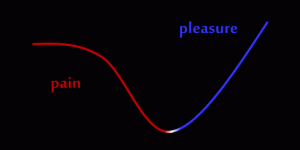A Lesson From Tough Times

Think of someone who causes a sense of admiration when you recall the tough stuff they’ve been through and still managed to keep it together. How did they do it?
Lao Tzu said that the person who conquers others is strong while the person who conquers him/herself is mighty. How do you do that? Is there a formula?
It is precisely the extreme events of our life
that show us the essence of growth.
My personal experience of “intense” change includes moving unexpectedly at the age of 13 from Canada to a tiny Island of Portugal; losing quite a bit of weight (25 kg/55 lbs), and a career change.
More importantly, I’ve seen others go through much tougher events, such as an unjustly large jail sentence, the shaking news of a terminal illness, the untimely death of a son or the raw suicide of a sibling.
What does it take for us to change or overcome imposed change? In all these situations, I’ve noticed two defining forces that allow us to effect change or to overcome imposed change: pain and pleasure. I call them “The Curves of Change”.
The curves apply both to a desired change we wish to implement or an imposed change we wish to overcome.
Pleasure makes change desirable.
Pleasure is an attracting force: it pulls us to change. When faced with a situation to overcome, visualizing the pleasures that we will receive creates the desire to change.
For ex., when my family and I moved, the desire to make friends impelled me to quickly improve my Portuguese. When I lost weight, the idea of being slimmer made me want to exercise. When I changed career, the hope of more freedom fueled me to complete another master’s.
When we want to change, the first step is to visualize the pleasures that will be obtained as a result of changing. This provides the motivation to take action.
Pain makes change inevitable.
Pain is a repelling force: it pushes us to change. Pain is more effective than pleasure. Often there’s a taunting voice in our head: “It’s too hard. It’s not worth it. Not now.”
The efforts involved in changing can sway us to give up and settle for the way things are. The solution to reducing the pain involved in changing is to emphasize the pain involved in not changing!!
The solution to overcoming
great pain is a greater one.
For ex., when we moved, feeling ridiculous when I talked helped me overcome the challenges of an unfamiliar language. As I lost weight, the idea of feeling tired again drove me to stick to months of strict dieting. When the uncertainties of a new career made me doubt, the thought of another month doing the same thing pushed me forward.
The second step is to reduce the pain involved in changing by emphasizing the pains of not changing. This eases the feeling of discomfort involved in changing and gives us the stamina to endure.
Have no doubt, the road of change turns to lessen pain and curves to enhance pleasure. Be sure to look at it from this perspective. To successfully effect any change, engage in increasing pleasure and getting rid of pain!
What roles to pain and pleasure play in the curves of your change?


